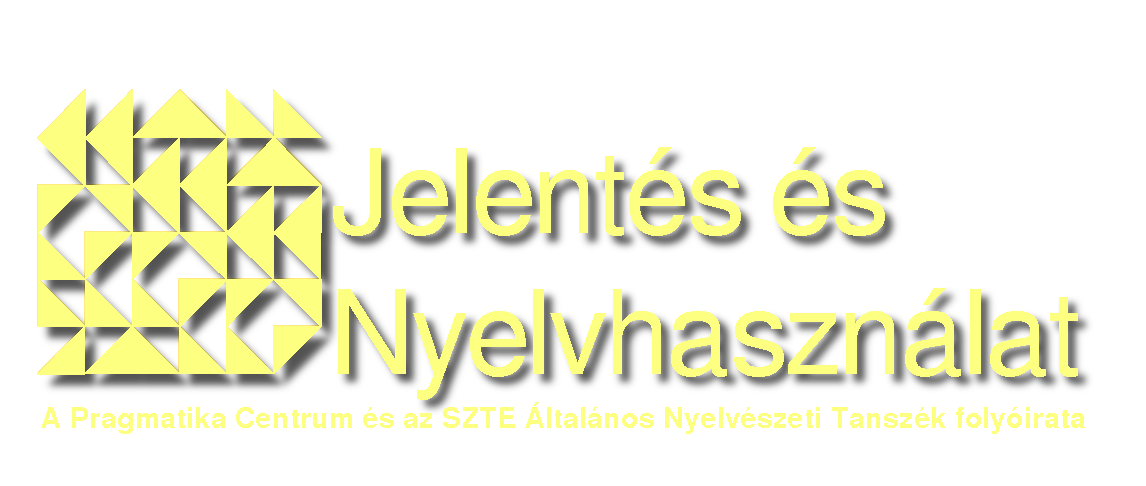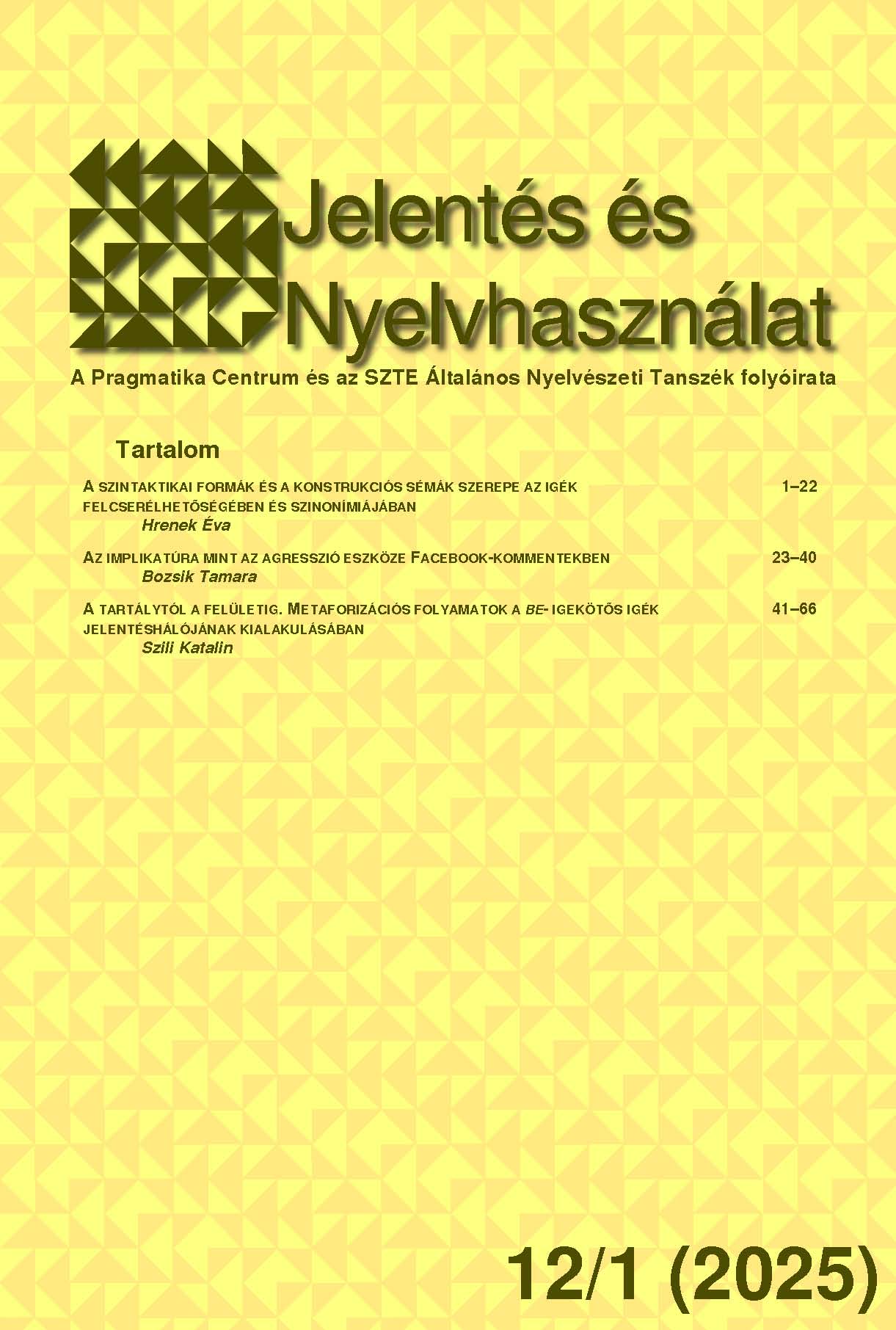On the role of jó 'good' as an intensifier in 16th–18th century text types A jó intenzitásjelölő szerepéről 16–18. századi szövegtípusokban
Main Article Content
Abstract
Variation of intensifiers is a prominent research area for historical semantics and pragmatics. Nevertheless, the structural, semantic, and pragmatic characteristics of individual intensifiers also require investigation in some cases. An example of this is jó ’good’, which has been attested since the Old Hungarian period with the meaning ‘big (amount)’ and ’very’ as well. Building on speech related sources between the 16th and the 18th century, it was rare and occurred before only a few targets. The aim of this paper is to contrast and complete the previous observations involving an extensive dataset from cookery and medical recipe collections of the period. Considering this group of sources, the intensifier jó ’good’ proved to be a register-specific feature. In terms of frequency and collocation patterns, jó varies with the main variant of the period (igen ’very’) before some of the targets but different communicative goals (persuasion vs. instructions) may have motivated the choice between the variants. However, before a special group of quantity markers, jó was the exclusive intensifier in the period.
Downloads
Article Details

This work is licensed under a Creative Commons Attribution-NonCommercial-NoDerivatives 4.0 International License.
References
Anthony, Laurence 2023. AntConc. V4.2.4. Tokyo: Waseda University. https://www.laurenceanthony.net/software/AntConc.
Binder Jenő 1889. A magyar hasonlítás. Magyar Nyelvőr 18/6:241–249.
Claridge, Claudia – Ewa Jonsson – Merja Kytö 2024. Intensifiers in Late Modern English. A Sociopragmatic Approach to Courtroom Discourse. Cambridge: Cambridge University Press. https://doi.org/10.1017/9781108560627.
Claridge, Claudia – Merja Kytö 2021. Degree and related phenomena in the history of English: Evidence of usage and pathways of change. Journal of English Linguistics 49/1:3–17. https://doi.org/10.1177/0075424220969778.
D. Mátai Mária 1992. A határozószók. In Benkő Loránd – E. Abaffy Erzsébet – Rácz Endre (szerk.) A magyar nyelv történeti nyelvtana II/1. A kései ómagyar kor. Morfematika. Budapest: Akadémiai Kiadó. 570–661.
D. Mátai Mária 2003. Szófajtörténet. In Kiss Jenő – Pusztai Ferenc (szerk.) Magyar nyelvtörténet. Budapest: Osiris Kiadó. 393–429.
D. Mátai Mária 2011. Magyar szófajtörténet. Budapest: Argumentum Kiadó.
Dixon, Robert M. W. 2004. Adjective classes in typological perspective. In Robert M. W. Dixon – Alexandra Y. Aikhenvald (szerk.) Adjective Classes: A Cross-Linguistic Typology. Oxford: Oxford University Press. 1–49. https://doi.org/10.1093/oso/9780199270934.003.0001.
Dömötör Adrienne – Gugán Katalin – Novák Attila – Varga Mónika 2017. Kiútkeresés a morfológiai labirintusból: Korpuszépítés ó- és középmagyar kori magánéleti szövegekből. Nyelvtudományi Közlemények 113:85–110. https://doi.org/10.15776/NyK.2017.113.3.
Ghesquière, Lobke 2021. “A good deal of intensity”: On the development of degree and quantity modifier good. Journal of English Linguistics 49/2:159–181. https://doi.org/10.1177/0075424220980046.
Gugán Katalin 2022. „Félő, az Isten is el ne hagyjon” – Pleonasztikus tagadás a középmagyarban. In Forgács Tamás – Németh Miklós – Sinkovics Balázs (szerk.) A nyelvtörténeti kutatások újabb eredményei XI. Szeged: Szegedi Tudományegyetem Magyar Nyelvészeti Tanszék. 95–111.
Kuna Ágnes 2024. Fejezetek a receptirodalom történetéből. A 16–17. századi magyar orvosi recepthagyomány nyelvészeti megközelítése. Budapest: Szépirodalmi Figyelő Alapítvány.
Kuna Ágnes 2025. Orvosi korpuszok és történetiség. Jelentés és Nyelvhasználat 12/2:37–55. https://doi.org/10.14232/JENY.2025.2.4.
Kuna Ágnes – Kocsis Zsuzsanna – Ludányi Zsófia 2017. A Magyar orvosi nyelv 16–17. századi alkorpusza. Tervezet, átírás, annotálás. In Forgács Tamás – Németh Miklós – Sinkovics Balázs (szerk.) A nyelvtörténeti kutatások újabb eredményei IX. Szeged: Szegedi Tudományegyetem Magyar Nyelvészeti Tanszék. 239–253.
Lorenz, Gunter 2002. Really worthwhile or not really significant? A corpus-based approach to the delexicalization and grammaticalization of intensifiers in Modern English. In Ilse Wischer – Gabriele Diewald (szerk.) New Reflections on Grammaticalization. Typological Studies in Language 49. Amsterdam: John Benjamins Publishing Company. 143–161. https://doi.org/10.1075/tsl.49.11lor.
Novák, Attila – Katalin Gugán – Mónika Varga – Adrienne Dömötör 2018. Creation of an annotated corpus of Old and Middle Hungarian court records and private correspondence. Language Resources and Evaluation 52/1:1–28. https://doi.org/10.1007/s10579-017-9393-8.
Oravecz, Csaba – Tamás Váradi – Bálint Sass 2014. The Hungarian Gigaword Corpus. In Nicoletta Calzolari – Khalid Choukri – Thierry Declerck – Hrafn Loftsson – Bente Maegaard – Joseph Mariani – Asuncion Moreno – Jan Odijk – Stelios Piperidis (szerk.) Proceedings of the Ninth International Conference on Language Resources and Evaluation (LREC’14). Reykjavik: European Language Resources Association (ELRA). 1719–1723.
Quirk, Randolph – Sidney Greenbaum – Geoffrey N. Leech – Jan Svartvik 1985. A Comprehensive Grammar of the English Language. London: Longman.
S. Hámori Antónia 2008. Melléknévi alaptagú szószerkezetek középmagyar kori szövegeinkben. In Haader Lea – Horváth László (szerk.) Tanulmányok a középmagyar kor mondattana köréből. Segédkönyvek a nyelvészet tanulmányozásához 89. Budapest: Tinta Könyvkiadó. 88–109.
Sass Bálint 2017. Keresés korpuszban. A kibővített Magyar Történeti Szövegtár új keresőfelülete. In Forgács Tamás – Németh Miklós – Sinkovics Balázs (szerk.) A nyelvtörténeti kutatások újabb eredményei IX. Szeged: Szegedi Tudományegyetem Magyar Nyelvészeti Tanszék. 267–277.
Simonyi Zsigmond 1880. Ragvesztett határozók. Magyar Nyelvőr 9/7:314–319.
Simonyi Zsigmond 1913. A jelzők mondattana. Nyelvtörténeti tanulmány. Budapest: Magyar Tudományos Akadémia.
Varga Mónika 2022. „Alkalmas ideig gyötörte”. Pragmatikai markerek funkcióinak alakulásáról 16–18. századi regiszterekben. Jelentés és Nyelvhasználat 9/1:133–153. https://doi.org/10.14232/jeny.2022.1.6.
Varga Mónika 2024a. Felette igen nagy jó – Intenzitásjelölők variációja 16–18. századi regiszterekben. Argumentum 20:194–223. https://doi.org/10.34103/ARGUMENTUM/2024/11.
Varga, Mónika 2024b. So very good! Intensifiers in historical registers: a comparison of Hungarian and English. Előadás. 1st Contrastive Pragmatics Symposium. Budapest: Hungarian Research Centre for Linguistics. 2024. július 18.
Varga Mónika 2025. Rettenetes friss, iszonyú sok, szörnyű vígság: negatív emotív intenzitásjelölők variációjáról 16–18. századi szövegtípusokban. Argumentum 21:41–66. https://doi.org/10.34103/ARGUMENTUM/2025/5.
Veres Ignác 1880. A melléknév tanához Petőfiből. Magyar Nyelvőr 9/7:307–314.

